Choosing the Right Roof for Your Home: J&L’s Best Roofing Materials Guide

- Written by: jlbmdev

Your home is your biggest investment, and your roof is the cherry on top, so to speak. Similar to a home’s foundation, a tattered and decrepit roof is more than an aesthetic problem. It can cause water build-up and damage in the interior of your home, mold and mildew, and higher utility bills due to poor ventilation.
In the newest installment of our Best Materials Series, we’ve created a best roofing materials guide to help you know what types of roofing materials to consider when it’s time to install a new roof. That way you can get the most out of your investment for years to come.
If your roof is fairly new but showing signs of damage (such as after a heavy storm) like cracks in a few shingles or a minor water leak, then a repair may be all you need. However, if it seems like your roof has sustained serious structural issues (such as significant water damage or weak parts in the foundation of your roof), then a replacement may be in order.
If you’re noticing higher-than-usual electric bills, your roof could be the culprit. As your roof weakens and air pockets emerge, it grows less and less efficient in trapping cool air or heat within your home. This means your AC or heating system will have to work harder to regulate the temperature of your home. If this is happening to you, you may want to consider a complete roof replacement.
Keep an eye out for cracked, damaged, or buckling shingles. Shingles should lie flat against the roof, so anything that looks misshapen or out of place may be a sign of damage.
A droopy and sagging roof is another indication it’s time for an upgrade. If your roof looks soft and even warped, be sure to check the surface for any trapped moisture, rotting boards, or sagging spots.
Finally, beware of moss growing on certain parts of your roof. While it may look magical and enchanting in a forest, it’s usually indicative of trapped moisture between a roof and the structure of your home.
Be sure to take precautions when inspecting your roof. While visibly assessing and gently testing your roof for any damage is fine, we recommend contacting a professional for a more in-depth inspection to avoid any injuries on your part.
There are more than a few types of roofing materials to choose from. After some careful consideration, you may even find yourself choosing a different type of roofing material than the current material you have. To help you choose the right roofing material for your home, we’ll help you weigh your options — from appearance, longevity, and cost.

Durable, affordable, and available in a wide variety of colors, asphalt shingles are a popular choice for roofing. Made of fiberglass, asphalt shingles are the “people’s choice” when you’re looking for something more basic yet effective.
However, asphalt shingles can fade over time and may need to be updated about every 20 years, depending on your climate.
Lifetime: Asphalt shingles can typically last around 30 years before they need to be replaced.

Slate shingles are some of the longest-lasting roofing materials available. They’re also one of the more expensive listed in this roofing materials buying guide. Available in hard and soft forms, slate shingles are ideal for durability and endurance.
Part of what makes slate shingles so long-lasting is they are water- and fire-proof and resistant to mold and fungus. However, they require a large upfront investment and professional installation.
Lifetime: A slate roof can last between 100 to 200 years.

For a natural and rustic look, clay and concrete tiles are an attractive choice for homeowners. Clay and concrete shingles are popular for homeowners dwelling in hot climates since they’re durable, fire-resistant, and slow to absorb heat.
One of the drawbacks to clay and concrete tiles is that they are a heavier material so they need extra framing and should be installed by professionals.
Lifetime: On average, both types of shingles have an average lifespan between 50 to 100 years.

Durable and virtually maintenance-free, metal roofs are great at reflecting heat and are nonflammable. Another benefit of metal roofs is that they’re an eco-friendly option that can be recycled when they finally wear out. However, depending on the weather, certain types of metal roofing can be quite noisy during a rainstorm or hailstorm.
The most common metal roofing materials are painted and coated steel and copper. There are two styles of metal roofs: standing seam and metal shingles or shakes.
Lifetime: On average, a metal roof will last between 40 to 70 years.

Wood shingles add a natural and rustic touch to a home and are an energy-efficient roofing material since wood is a good insulator. Its cellular structure helps stop heat from escaping, keeping it in your home. Wood roofing materials are usually available in two types: wood shingles and wood shakes.
Shingles are often machine cut, sawn on both sides and are usually thinner than shakes. Wood shakes are typically composed of cedar and split by hand and/or power equipment. They’re often less uniform than shingles, making each roof made up of wood shakes unique and one of a kind.
Both wood shingles and shakes require upkeep every few years. From cleaning, treating for pests, and resealing them to prevent water damage, wood roofs are high maintenance.
Lifetime: On average, wood shingles and shakes will last around 30 years.
For homeowners who love the look of cedar or slate but don’t like the upkeep, synthetic shakes and shingles are a terrific option. Synthetic (sometimes referred to as composite) are made of recycled materials and designed to look exactly like cedar or slate while boasting the durability and longevity of synthetic materials.
DaVinci Roofscapes offers a synthetic shake known to last decades without the maintenance issues of typical cedar shakes. Able to handle winds up to 110 miles per hour, DaVinci offers single-width, multi-width, bellaforté, select shake, and hand-split options.
Currently, synthetic shingles and shakes are significantly cheaper than wood or slate, and their durability and virtually maintenance-free options can provide a greater return on investment than their traditional wood counterparts.
Lifetime: On average, synthetic shingles and shakes can last up to 50 years.

With proper installation, rubber composite shingles are incredibly weather-resistant and can withstand strong winds up to 110 miles per hour. They’re also an excellent choice for withstanding extreme weather conditions and have been tested to withstand impact from hail up to 2 inches in diameter.
Lifetime: On average, rubber shingles can last for 30 years or more.
With all the options on the market, is there one high-quality roofing material that’s the best? Like our other materials recommendations, it depends on you. If you’re someone who doesn’t mind being more hands-on with maintenance, then wood or asphalt shingles might be the right for you. Or if you’re willing to increase your budget, you might choose a metal roof over rubber composite.
Doing your research and creating a budget will help you choose the right roofing material for your home. So we created a chart to help get your research started.
| Type | Cost | Durability | Maintenance |
|---|---|---|---|
| Asphalt | $ | 20-30+ years | Medium |
| Slate | $$$ | 100-200 years | Low |
| Clay/Concrete Tile | $$ | 50-100 years | Medium |
| Metal | $$$ | 40-70 years | Low |
| Wood | $$$ | 30 years | High |
| Synthetic | $$ | 50+ years | Low |
| Rubber Composite | $$ | 30+ years | Low |
Note: Estimated costs do not include labor. We recommend contacting a trusted contractor for an accurate and up-to-date estimate.
It’s not just the different types of roof shingles you need to consider before starting the project. Cost, contractors, and warranties are three important factors to consider when choosing a roof. As part of our guide to roofing materials, let’s explore how to make the most of your budget and find a contractor experienced in roofing repair and replacement.
The national average cost to replace a roof is around $8,000, and that price is mainly made up of the type of roofing materials you choose and how big your home’s roof is. Another factor that can affect your cost is labor cost. The size and slope of your roof will help determine a portion of your labor cost.
If you’re strapped for cash and in need of immediate repairs to your roof, you can ask the bank for a personal loan, inquire about a home equity line of credit, or look into home improvement grants such as the Repairing and Improving a Home program.
As with all home improvement projects, determining your budget will help you figure out what you realistically can and can’t do. As we mentioned above, asphalt shingles are going to be one of the more affordable roofing options for a budget-conscious homeowner. If the price of a new roof is of no concern to you, then any roofing material will likely work, though you’ll still want to keep in mind components like weather resistance and maintenance needs.
It’s important to understand the warranty on your new roof. Your roof’s lifespan will depend greatly on installation, climate, and maintenance, and having a warranty will help protect your investment.
There are several types of roofing warranties: manufacturer, contractor, or full system. Research each type to see which one you’ll need or want to cover your roof.
When evaluating warranties, check the length of the policy, what’s covered (manufacturer’s warranty for material defects, labor to repair material defects, installation, workmanship, etc.), and homeownership warranty transferability.
If you only take one thing away from this roofing materials buying guide, it should be the importance of finding trusted contractors. If your contractor isn’t experienced with installation, working within a certain timeframe, and staying as close to your budget as possible, then your roofing remodel or repair will be a disaster.
Before signing a contract, always be sure to learn as much about the contractor and their working style before entering into a final agreement.

No matter what type of roof you have and how durable the materials are, roof maintenance is essential to prevent leaks and make the structure last longer. The last thing you want is to have your brand new roof suffer serious damage because of a lack of proper routine maintenance.
To help you get the most out of your new roof, below are a few basic maintenance tips to help you protect your investment:
Now that you’ve read our best roofing materials guide and made your decision on what high-quality roofing materials you’re getting, you get to order the materials and get started on your project.
Thankfully at J&L Building Materials, we have everything you need under one roof. From affordable roofing options to your dream roof, our team can help you and your contractor find long-lasting roofing solutions.
Don’t have a roofing contractor? Check out our trusted network to find the right fit for your project.
At J&L, we help our customers choose the right roofing materials, so no matter the job, you can be sure you’re in good hands.